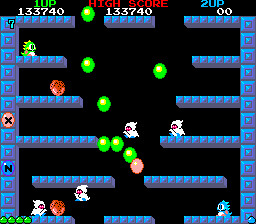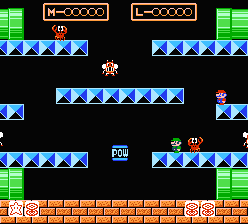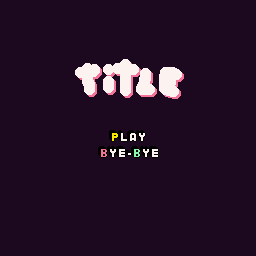Arcade Battle Arena Challenge!
Make a game like the classics Bubble Bobble and Super Mario Bros 3 Battle Mode. Those games involve one or two players battling against waves of enemies on an arena.
Game Requirements
-
The game must have:
- Start screen
- Key to return to the start screen
- Score system
- Minimum of 2 enemies with different behavior (AI)
- Graphics at least for the UI, player and enemies
- Sound effects at least for when the player is hurt and when an enemy is killed
- The actual gameplay must happen on a single screen (no camera translation)
Art Requirements
- The game can be 2D or 3D
- The art must use a maximum 16 colors palette
- The art must be your own
Tips
-
An interesting game design approach of the two games is that they require the player to neutralize the enemy first, before killing it:
- In the Super Mario Bros 3 Battle Mode, to kill an enemy, the player must first hit underneath the platform where the enemy is walking on
- In Bubble Bobble, to kill an enemy, the player must first shot a bubble on the enemy
- You can quickly make sound effects on Chiptone
- You can decrease your color count by replacing two similar colors with a median between the two colors. This works nicely for similar dark colors or similar light colors
-
Enemy behavior can involve:
- Response to the environment. What is the kind of tile that the enemy is currently at? What are the kind of tiles that are in front or behind the enemy?
- Response to the player. Where is the player? Is it too far away? Is it close? In front or behind? How the enemy will respond to that?
- Motion pattern. Does the enemy walk on the platform and stop for some time? Does it fly? Games like Super Mario World are good examples with a great variety of enemy patterns.
- The tutorials on Youtube by Shaun Spalding teach some enemy programming. They are for Game Maker, but the logic can be translated to other game engine or framework:
Duration
4 weeks - October 6, 2017 to November 3, 2017
Submission
Post on this thread only your entries:
- Link to the executable (specifying the platform)
- Screenshots: if the screenshots are too big, post just a few, if they are small, you can post more, just don't take the entire space
- A small post-mortem, in the same post of the entry, is encouraged, where you can share what went right, what went wrong, or just share a nifty trick
- Source-code link is encouraged






